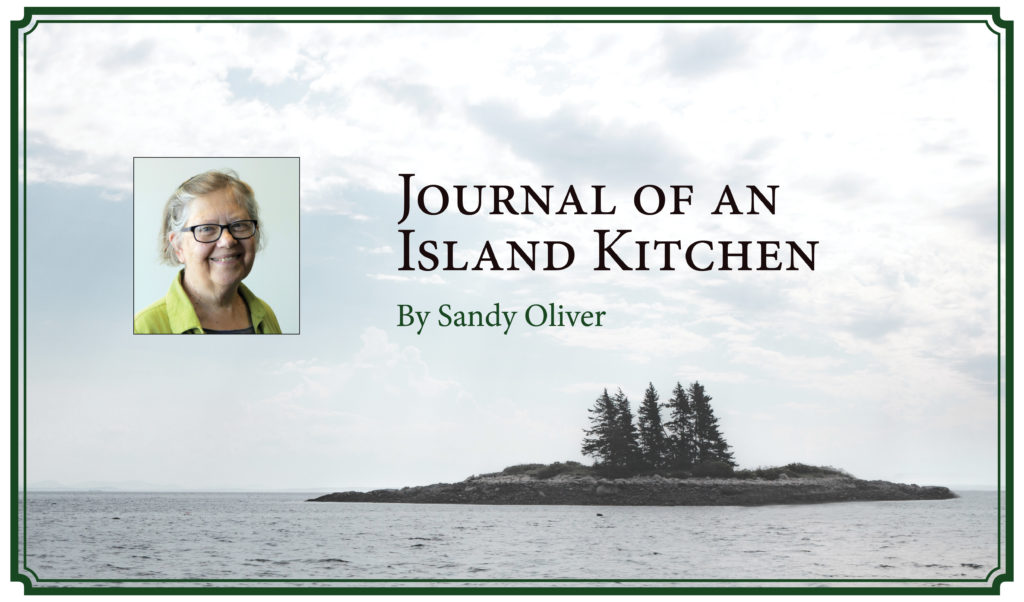By Sandy Oliver
There is a whole lot of canning going on out on Islesboro. Probably no one in Maine with a garden or access to plentiful vegetables is exempt from pickling, canning, freezing, drying, storing away.
It is September, which is “Putting Food By” month… well, not officially, merely practically.
While things are winding down in the summer visitors department, it is picking up speed in kitchens and gardens. There is a decided nip in the air driving the impulse to gather up and store away before frost.
One of the joys of moving to Islesboro so many years ago was finding that my peers canned. I remember elders canning when I was a youth, but in my 20s, hardly anyone I knew except older farmwives put food by, and my interest in storing the produce from a large garden we had was a little too unusual. Here on the island, though, it was routine, and I learned an awful lot from friends and neighbors.
About a week ago, Nancy across the street was putting up piccalilli; I was doing stewed tomatoes, tomato sauce, and dilly beans with tons of help from a summer friend, Gerry, who wanted to learn how to pack jars, fit lids, and process in a boiling water bath.
This week, Gerry brought peaches scavenged from a mostly untended tree and put up jars-full to take home to the city. I added some peaches to the canner, too, from my trees and six more quarts of tomatoes. In between the first batch and the latest were a big bunch of bread and butter pickles, relish, and dill pickles.
But we do not live by pickles alone. A solid collection of tomato sauce, or juice, which our neighbor Janis makes, plus canned peaches, stewed tomatoes, plus the other vegetables put by in the freezer and cellar, are the base-line winter food supply, and once I have them in place, then I feel like I can indulge in salsa, chutney, fancy little put-up jobs.
My friend Sharon who is the telemedicine nurse for the Seacoast Mission’s boat, the Sunbeam, is a prodigious canner. She and Tom have an ample garden, and I cannot fathom how she makes time to put food by in between making the plethora of arrangements for mainland doctors to meet islanders by telecommunication. She gave me a fabulous recipe for corn relish which makes a good addition to a salad plate, good enough to save some corn expressly for relish and not in the freezer.
When Gerry and I went hunting on the mainland for a canner and other equipment for her to take home—she plans applesauce—I was struck by the impressive displays which I don’t recall seeing before in various stores of canners, jars, lids and rings, tongs, jar lifters, funnels. A whole aisle close to the front of Reny’s in Camden!
And younger friends have asked to come to my house, to watch and help in order to learn more, or anything, about canning; I email or text them when I have a batch of vegetables in sight ready for jars. All this is evidence of serious interest in putting food by.
Over the years, I learned, usually the hard way, a few valuable lessons.
Be sure to put up what you actually like to eat in the quantities most useful to your household. Two dozen jars of chutney is impressive; but, really, how much can you, will you, eat?
Small batch canning makes it easier to stash vegetables as they come in. Unless you have a large patch of green beans, packing a normal canner full of dilly beans isn’t practical; small batch, converting a stock pot, for example, into a boiling water bath, makes it easy to put up two or three jars full at a time.
Adopt the practice of buying either all regular or wide mouth jars, but not both, so that you won’t have to keep two sizes of lids on hand all the time. Inevitably, you’ll runout of one or the other and living on an island makes it a nuisance to acquire more.
Similarly, buying cider vinegar, my preferred, in spring and early summer means that by the time you are ready to pickle you will have some on hand. So many times I’ve looked for vinegar in a mainland store in August or September only to find that section of shelf empty. It isn’t like we can just pop in on another day to restock.
Sandy Oliver is a food historian who gardens, cooks, and writes on Islesboro.





